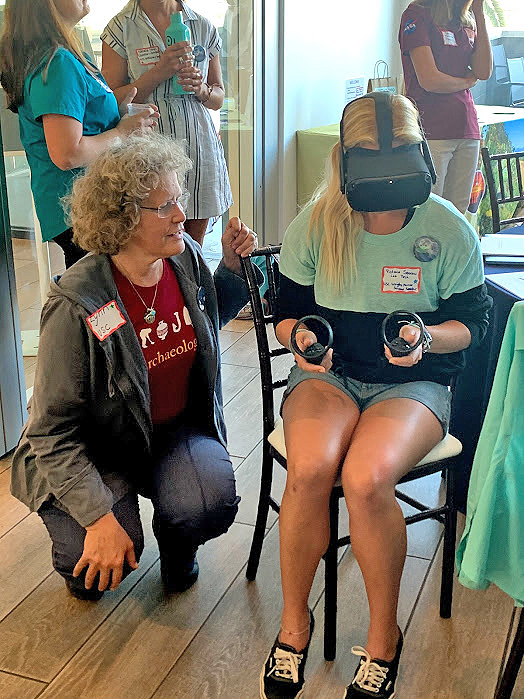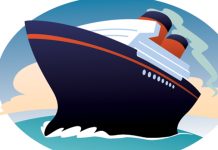
Catalina Educator Symposium organized by Catalina Island Conservancy
Educators across the Island came together for the Catalina Educator Symposium on Oct. 23, organized by Catalina Island Conservancy. More than 30 education thought-leaders gathered at the Trailhead for the opportunity to network, share and collaborate about connecting with learners of all ages to share the beauty and uniqueness of the Island through experiential learning.
Sarah Marcotte, public engagement specialist, NASA’s Mars Exploration Program, Jet Propulsion Laboratory, kicked off the program with an inspiring keynote address, detailing the public engagement pathway they use for effective communication. She spoke about how museums and facilities used to be seen as holders of information, but now “understand that you’re a co-creator of it. For us, engagement is a dialogue – it’s a two-way street.”
The goal of the public engagement pathway is to promote awareness and inspire participation and action. Tools such as social media, print products, interactive experiences, events, community science and more help lead to an audience interacting more deeply with brands.
To best engage an audience, Marcotte recommends getting people hooked in with stories. “Let’s start with stories as opposed to starting with data. Let’s give them something compelling to learn about,” she said, adding that science and data bring authenticity and truth to these stories. “Human beings have been sitting around campfires for hundreds of thousands of years. Storytelling is woven into us.”
In addition to the keynote, three speaker sessions tackled how to measure your impact, taking idea to action, and creating successful partnerships. Catalina Island Conservancy Director of Education Dr. Leah Melber spoke about incorporating evaluation as an important of measuring program impact.
Hillary Holt, Catalina Island Conservancy Outreach and Interpretation Specialist, shared about the Conservancy’s programs, including Families in Nature, Course Catalina, and NatureWorks, with its NatureWorks in the Classroom with K-12 students, Island Scholars, and Kids in Nature. Facilities for deeper learning, such as the Conservancy Nature Center in Avalon Canyon and Wrigley Memorial & Botanic Garden, provide more opportunities for hands-on learning, and interpretive displays at Airport in the Sky and the Trailhead engage visitors at popular stops.
The educators agreed that Catalina is a unique, amazing place for sparking a love for science and nature. Kathleen Hill Carlisle, who provides astronomy tours on the Island, called it “the most beautiful laboratory in the world.”
Many programs work to inspire change, on both a global and individual scale.
Associate Director for USC Wrigley Institute Ann Close said that they are “trying to find solutions to environmental problems through education,” all while leading by example. They do this with sustainability-focused actions, including drying food waste.
The Boy Scouts have a strong presence on Catalina. Lee Harrison, Deputy Scout Executive of the Western Los Angeles County Council, Boy Scouts of America, said that their program works to “create a world in which people make ethical choices over their lifetime.” The Scout camp at Emerald Bay is particularly focused on energy consumption.
Emerald Bay Director of Facilities Nathan Erlandson said that the campers “have unknowingly partnered with us in a lot of areas” through modified actions. They’re working to eliminate single-use cups by offering a water bottle filling station with filtered water; there is a small compost bin in the garden, as well as ecology classes that help to compost food prep scraps from the kitchen. Not only are campers seeing rain barrels and dew collection apparatuses that collect water used to nourish native plants, they are also seeing educational signage that explains how much water different actions – such as taking a shower – use. “The campers seem to be taking a personal investment and involvement because it’s sustainable,” he added.
USC Associate Professor of Religion Lynn Swartz Dodd and Fowler Museum at UCLA Curator of Archaeology Wendy Teeter spoke of the importance of interactive, virtual reality engagement. “Using 3D provides access in a sustainable way,” said Dodd. She added that the target audience isn’t those who live on and have had a chance to explore the area, “it’s for everybody who doesn’t get to come to Catalina Island who may be missing out on incredibly interesting stories.”
They are working on VR experiences of the Island, including one that tells the story of Eagles Nest Lodge. “It allows people to create their own learning by virtue of exploring,” said Dodd.
Teeter said that the Pimu Catalina Archaeology Project provides information about the Island’s longevity, “teaching that you are on Tongva ancestral land.” With VR, they use resources that have come from the Island and keep them generating new ideas and theories. “Having that interactive experience makes for much more full understanding and takeaways,” she said.
The Symposium wrapped up with a post-program opportunity to continue conversation at Toyon Grill.
“The 2019 Educator Symposium was a fantastic opportunity for educators from around Catalina to have a full day to connect, share best practices, and even plan for future collaborations,” said Melber. “While meetings like this are incredibly beneficial to our individual organizations, it’s really those who take part in our programs- who come to Catalina to camp, learn, explore, and recreate- that ultimately benefit from these learning exchanges.”










